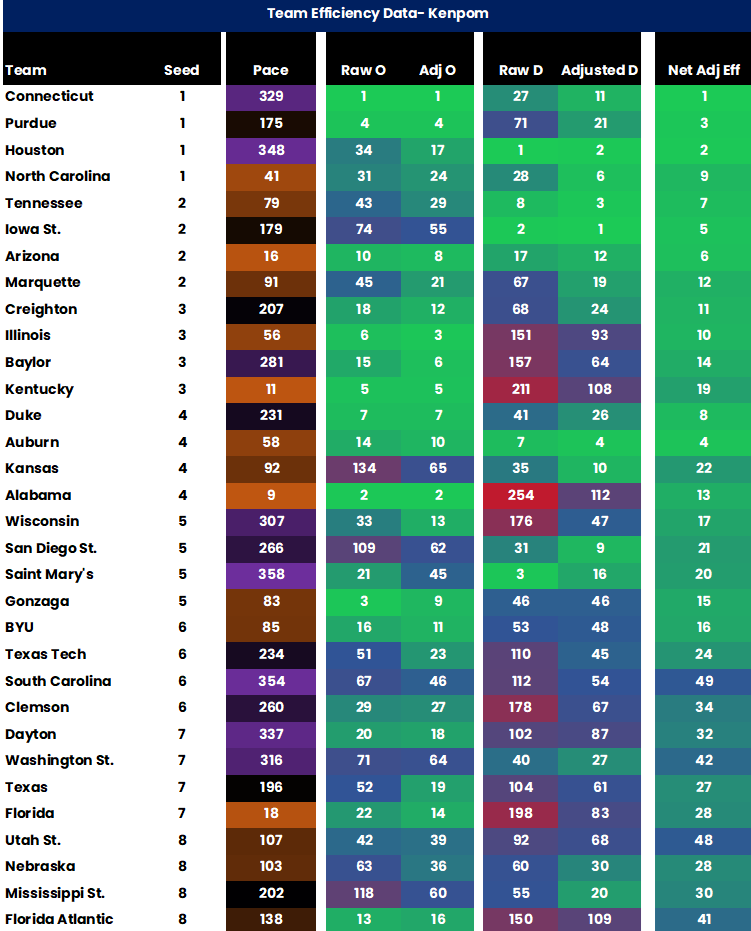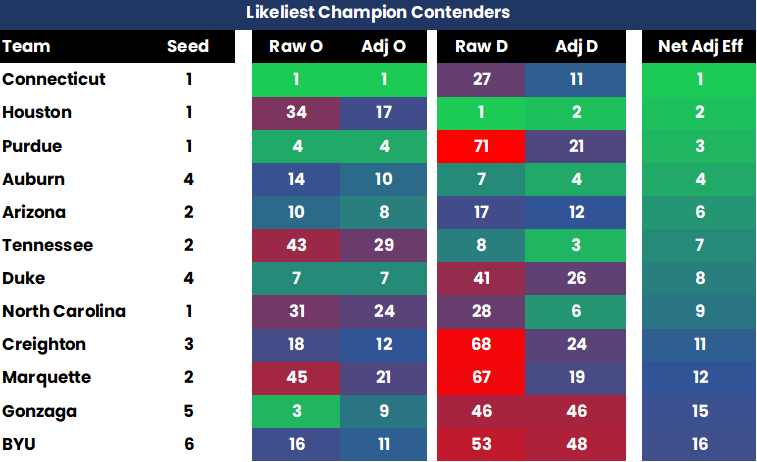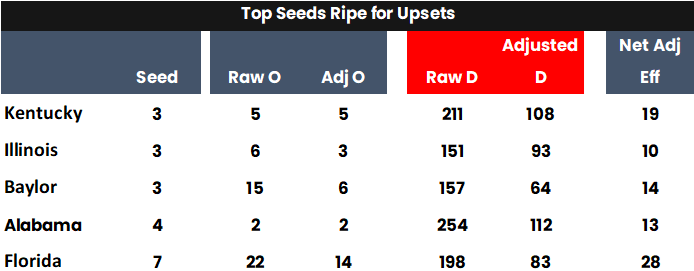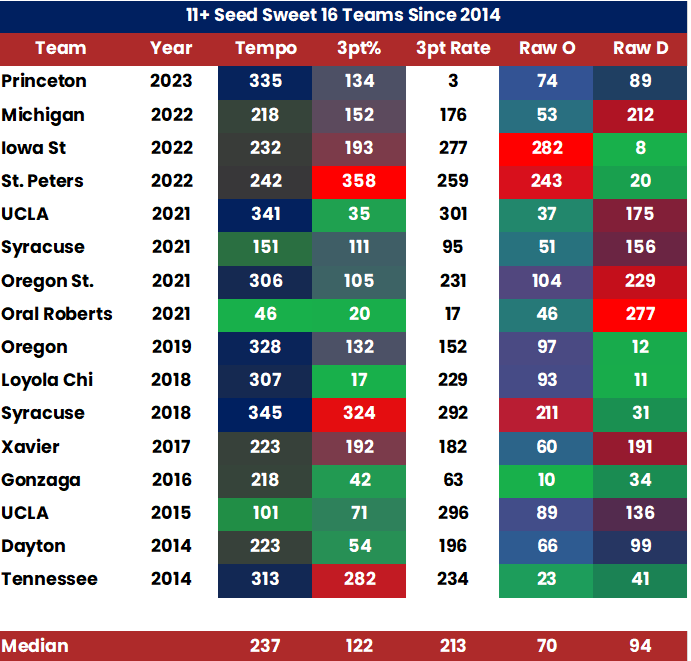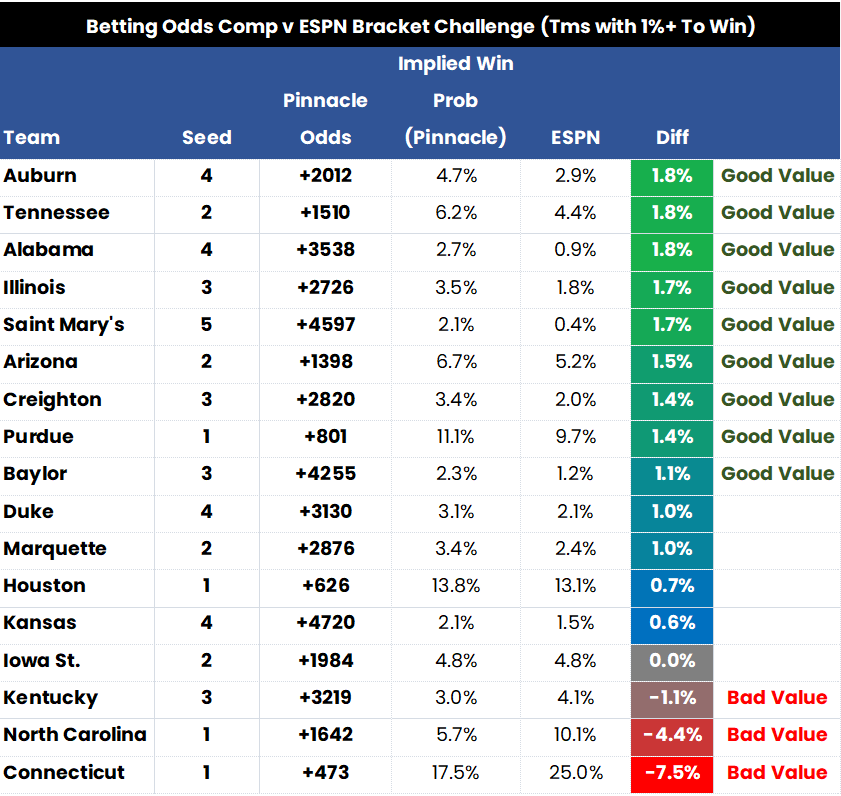2024 MARCH MADNESS BRACKET PREVIEW
March Madness is upon us once again and for many this is the best sporting event of the year. Even for those who don’t care much about college basketball or even have not paid any attention during the season, there is a likelihood that you will be filling out a bracket. First and foremost, this is freaking hard and hate to break it to everyone out there but there is a very high likelihood that you won’t win your pool. Even the people who have watched and studied the game all season, they struggle as much or even more to get things right. In fact, there doesn’t seem to be a strong correlation at all between those who have paid a lot of attention to college basketball and those who have just started paying attention.
With that being said, I do believe that are some solid rules to follow when filling out a bracket that can help give you even the smallest of edges on your competition. Below, I will take a look at some different categories of teams and the profiles of teams that historically have won the title, been knocked out early or have been the teams to upset multiple higher seeds and made deep runs. This is an inexact science to say the least and history doesn’t always repeat itself. This is as wide open a tournament that you will ever see so anything is possible! But I wanted to use this platform to potentially help you along the way. Feel free to follow some, all or completely ignore the historical profiles below. Your choice, I am just here to lay them out. in case you need the help. Note: I will be posting my bracket for smaller pools (<50-100 people) and larger pools (100+) by Tuesday or Wednesday at the latest.
I want to be clear here, I don’t follow college basketball nearly as religiously as I once did so you will not be getting any sort of team by team breakdowns with player profiles, etc. That is not what I am here for and would never pass myself off as such. There are much better resources for team breakdowns and would encourage you to use those if you want to learn more details about the players and teams. I would also strongly recommend good twitter friend Ed Feng’s bracket breakdown for some more bracket help and much more in-depth team by team analysis. He is much smarter than me and has a Stanford PhD. You can find his work here if interested.
My Process
Truth be told, like 95% of people out there, I just don’t have the time to religiously follow college basketball for a full season so I have really just dug deep over the last month. But I don’t have the knowledge to handicap all 64+ teams. And with that, the best route for filling out a bracket is to use tournament history and some basic tenants, to give you the best chance to compete in your pools and has rewarded me with some success in the past. I like to use a more top down approach on the front end with some bottoms up team matchups analysis at the back end.
Pool Size- Your bracket strategy should start with understanding the size of your pool you are competing in.
- The larger the pool (~100+ entrants) the more risks you should take although you should not be reckless. Measured upsets but you really have to nail many of your final 4 teams and the winner to have a real chance. Its ok to make a couple of upset predictions among teams seeded 10-13 but only fade those favored teams that you don’t think will advance far anyway and if you do call for the upset, only advance them one round. A bracket full of 12 and 13 seeds in the sweet 16 and Elite 8 has virtually no shot of winning.
- In smaller pools (<50-100 entrants), you really don’t have to make too many big risks with upsets. Fading popular favorites is really the best route but in general you don’t need to do too much more than backing the teams with the highest win probability throughout or just using my table below and picking the teams with the higher overall kenpom ratings. In both pool size instances, pay attention to the spreads of the round one games and if a double digit seed is favored over the higher seeded team then that could be the type of seed “upset” to pick. This really isn’t an upset based on win probability but the average contestant might not have in their bracket. Also compare the true implied betting odds for each round and to win the tournament for teams versus the public bracket challenge data posted on ESPN. If you see a wide gap between actual win probability odds and what the general public is selecting in pools, that gives you a good proxy for your pool and potentially selecting the undervalued team and lead to differentiation. The goal with any of these brackets is not to pick the perfect bracket (that will lead to a likely poor bracket) but the goal is to just beat the competition.
2. Past Data– Using historical data, you need to narrow down the field to the handful of teams with the best realistic shot to win. Same with fading those higher ranked teams (seeds 1-7) who have historically profiled as teams that don’t typically advance far in the tournament. Again, nothing is perfect and even 20+ years of results is a fairly small sample size. There will be outliers but most likely very few if anyone else in your pool will have those outliers winning it all so you don’t have to be perfect. (see below for much more detail)
3. Seed Analysis/Notes- Understanding what tournament history says about how often and how far different seeded teams advance and using that baseline to help you project your bracket. It’s just a nice guide and absolutely doesn’t mean this tournament will fall exactly as it has throughout history. But just some notes to keep in mind:
- The non 16 seed play in game has existed for the last 12 seasons. In 11 of those tournaments, at least one has advanced to the round of 32. UCLA in 2021 and VCU in 2011 made it all the way to the Final 4 and three others reached the sweet 16. Last year, we saw Pitt upset Iowa St in round one while ASU just missed an upset over TCU by 2 points. Don’t be afraid to advance one of these teams.
- A top 4 seed has lost in the opening round in 14 of the last 15 tournaments. Last year three teams (#1 Purdue, # Arizona, #4 Virginia) lost in round one.
- In 15 straight tournaments, a team seeded 10 or higher has made it to the Sweet 16. #15 Princeton advanced to the Sweet 16 last year.
4. Matchup Model– After using the historical data and current odds as a backdrop, I use my season long matchup model to make other game to game selections. If you are in a smaller pool you likely don’t even need this, you can just advance the higher ranked kenpom team throughout with a couple of decisions in close games.
2024 Tournament Efficiency
data c/o kenpom.com
Title Contenders
Lets take a historical look at the profile of an NCAA tournament champion. Below are the pre tournament Kenpom rankings across raw points per possession, adjusted offense, raw points allowed per possession, adjusted defensive efficiency and total efficiency margin since 2002.
- No team has won the NCAA tournament in the last 20+ years without entering the tournament in the top 25 of Kenpom’s overall ranking.
- In all but three cases (2003 Syracuse, 2011 Uconn and 2014 Uconn), every champion has been a top 6 overall team entering the tournament. In all three cases where the Champion did not rank in the top 6 overall by Kenpom, in each season those teams did have at least have one victory during the season over a Kenpom top 5 team. So at least they showed the ability to beat an elite team during the season.
- Only one time (2014 Uconn) has a team with an adjusted offensive efficiency of worse than 21st won the title. Besides that one outlier, every national champ entered the tournament as one of the better offensive teams in the country.
- The 2021 Baylor Bears (44th) and 2015 Duke Blue Devils (37th) are the only title winners to win the title with an adjusted defense that ranked outside the top 30. Both of those teams possessed elite offensive ratings (top 3 in adjusted off efficiency). So if you are going to look at a team with defensive metrics outside of the top 30, they better be elite on offense to make up for that deficiency.
When you include the runners-up as well, no team has made the NCAA tournament championship game with an adjusted offensive rating worse than 62nd, a defensive rating of worse than 69th or with a total net efficiency margin worse than 44th. The 2011 Butler Bulldogs were a big outlier, ranking 69th in adjusted defense and 44th in overall net rating. If you exclude that team, no runner up or title winner entered the tournament worse than 29th in overall net rating.
We have seen a trend of late where the more elite offensive teams are winning the title much moreso than elite defensive teams.
- Six of the last eight title teams came into the tournament outside of the top 15 in adjusted defense and four of those eight ranked 25th our worse. However, each of the last six title teams and eight of the last nine ranked top 7 in adjusted offense.
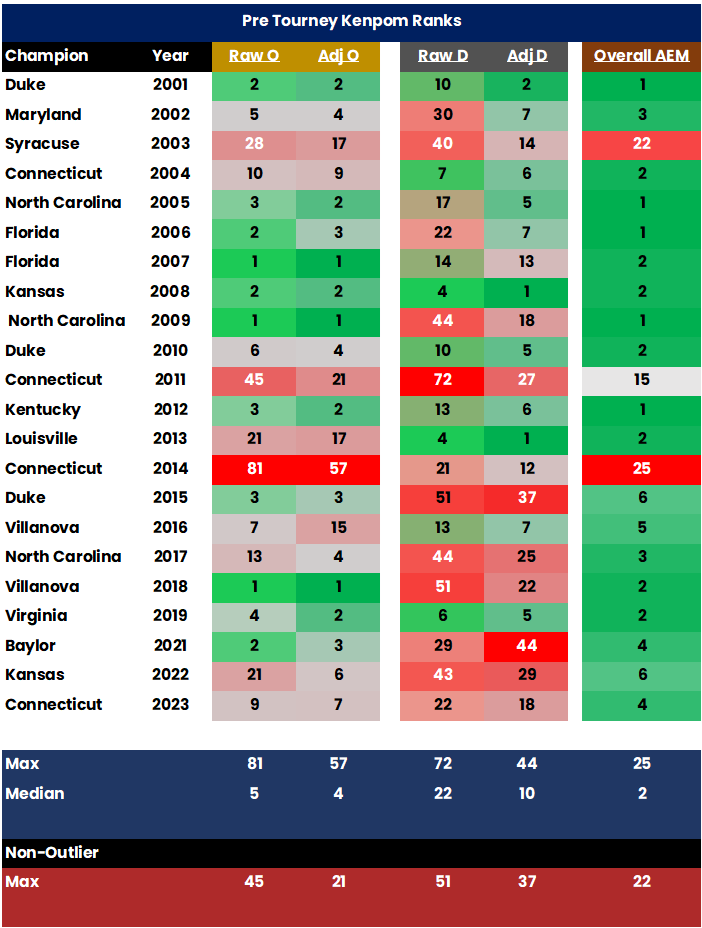
The analysis above is based on adjusted efficiency metrics but if we just look at the raw points per possession numbers for teams entering the tourney, with no adjustment at all for schedules, we get essentially an “unbiased” look at successful teams. Only one team (2014 Uconn) won the title with a raw offensive rank worse than 45th. The 2011 Uconn team is the only title team to win with a raw defensive rank worse than 51st. So even if you think that some teams get improper adjustment solely based on the competition they’ve faced, the raw data helps further filter the contenders.
To keep it fairly simple, I am using a filter for the teams that rank in the Kenpom top 25 overall, are top 30 in adjusted offense (also top 50 in raw pts/poss) and top 50 in adjusted defense (top 75 raw def pts/poss).
2024 Likeliest National Champs
My historical filters has led me to a list of 12 title contenders. You will notice I did not include the extended filter of teams outside of the top 6 in net adjusted efficiency who did not beat a top 5 kenpom ranked team. If I did that I would be able to reduce the true contenders even more.
- Tennessee, Creighton and BYU have beaten at least one top 5 team, however, Duke, UNC, Marquette and Gonzaga have not.
- UNC did beat #7 Tennessee and their one loss to #1 UCONN is the only other time all season that they even faced a top 5 team.
- Duke also did not face a top 5 team but did go 0-3 vs top 10 kenpom teams (UNC 2x and Arizona). They have one win over a top 15 team (#14 Baylor). They have not really proven to be able to beat the elites and frankly, I won’t be picking the Blue Devils to win in any of my brackets.
- Marquette, Creighton, BYU and Purdue also would be some of the worst defensive teams to ever win it purely based on points per possession ranks allowed. Only the 2018 Villanova Wildcats won with worse defensive numbers prior to adjustment.
- BYU and Gonzaga are the worst of the defensive teams among this group from an adjusted basis, and as mentioned in the historical breakdown above, when a title contender outside of the top 30 in adjusted rankings has won the tournament, they’ve also had top 3 level offense. BYU (11th) and Gonzaga (9th), are really good on offense but not necessarily that elite level historically that has made up for a defense that is just outside of the norms. I am going to keep them in here but they too would be a little outside of the teams that I will be picking to win it all.
- If I want to include some of these extended filters, it really narrows down my personal list of title winners to UCONN, Houston, Purdue, Auburn, Arizona, Tennessee and Creighton. I will also include UNC because I do believe that Tennessee and both Duke wins are clear signs they can beat really good teams. I am not going to exclude them for something like that.
- These will be the only teams that I will be picking in my brackets to win it all.
Final 4 Contenders:
- In the last 22 tournaments, among the 88 Final 4 participants, only one (VCU in 201 at #82) came into the tournament with a net efficiency margin ranking worse than 44th.
- Among the 88 Final 4 teams, only two (Louisville in 2012 and S Carolina in 2017) made it with an adjusted offensive efficiency ranking worse than 75th. They ranked 127th and 149th, respectively. However, they both were elite on defense, ranking 2nd and 3rd in adjusted defense those seasons. So if a major outlier on offense is going to make it, they better be among the best couple of defensive teams in the country. There is not a single team in the tournament this season that fits that outlier description with a poor offense but elite defense. Virginia (194th) and Duquesne (166th) are the highest seeds that would be eliminated from potential Final 4 based on this criteria.
- Only 4 of the 88 Final 4 teams since 2001 ranked worse than 69th on defense (Marquette in 2003, VCU in 2011, UCLA in 2021 and Miami FL in 2023). VCU is an outlier like no other team, in virtually every way. Those Marquette, UCLA and Miami FL teams were top 30 in adjusted offense and all three fit the top 44 total net adjusted efficiency ranks. So again, if you are going to be an outlier on defense, you better have a top shelf level offense. Illinois, Alabama, Kentucky, Dayton, FL Atlantic and Florida all would be outliers on defense but at least cleared the offensive and total efficiency ranking thresholds. They still would be very unlikely to make it if history holds.
- 89% of Final 4 teams since 2001 came into the tournament ranked inside the Kenpom top 25 overall. 76% ranked inside the top 25 in adjusted offense and 73% defensively. There will always be outliers but sticking to these rates will be a good benchmark.


Potential Vulnerable Top Seeds
Who are the top seeds that could be primed for a big upset early? There is a very specific historical profile for teams that I like to fade that fit certain parameters. Teams that don’t play consistently good defense, find it very difficult to string together multiple tournament wins in a row for a deep run. However, because we are looking for higher seeded teams (7 seed or better) that may fit the upset bill, they must have also been really good on offense in order to receive a high seed. Those are the types of teams we want to fade from making a deep tournament run.
So just going back to 2004, there have been 38 teams that have been a top 7 seed with a top 25 offensive points per possession but with a raw defensive efficiency ranking of 135th or worse. Among these 38 teams, 1 made the Final 4 (Miami FL in 2023), 4 others made the Elite 8 and 12 teams (!) were upset by a double digit seed in round one. Only three of the 15 teams that have met this category since 2017 have made it past round two. Last season, there were five such teams (Gonzaga, Baylor, Xavier, Missouri and Miami FL) and arguably performed the best overall in the last 20 years as a group. Baylor got upset by lower seeded Creighton and Missouri lost to #15 Princeton in round two. Xavier made it to the Sweet 16, Gonzaga the elite 8 and Miami FL the Final 4. But even in these cases, Gonzaga won two nail biters against TCU and UCLA to get to the Elite 8 before getting blown out by UCONN and Miami quite frankly got lucky in escaping 12th seeded Drake in the opening round after trailing by 8 with less than 5m in the game.
Even after the success from Miami and Gonzaga last season, I still would be hesitant to put many of my eggs in these teams baskets to go very far in the tournament.
Double Digit Cinderella
Every year the biggest question is who can be this year’s Cinderella? They come in all shapes and sizes but I will do my best to try and profile what historically has proven to be the characteristics that can match some teams this season. For point of reference, there have been 16 teams seeded 11 or higher to make the Sweet 16 since 2014 and at least one has made it in every year. And eight of the last 11 teams seeded 11 or higher to make the Sweet 16 have come from one of the big conference schools. Now let’s remember that this is a small sample of teams and there is lots of variance needed to win in an upset. Sometimes it’s as simple as a team getting hot from 3 or the opponent going ice cold, etc.
But a few things do stand out. For one, the median adjusted tempo that these teams played with ranked 237th in the country. Seven of the 16 teams that have pulled multiple upsets, had a tempo that ranked over 300th in the country including Princeton last season. Of those seven teams, five came from a Power 5 conference. So look for one of the big conference teams that play ultra slow as a potential sweet 16 upset candidate. Otherwise, the two teams that played the fastest tempo (2021 Oral Roberts and 2015 UCLA) also were excellent 3-point shooting teams. Oral ranked 17th and UCLA 71st in 3pt percentage so they could get away with a lot of possessions since they made a lot of 3s. But in general, a big chunk of these 11+ seeded teams that reached the Sweet 16 in recent memory, played at an extremely slow pace. And that makes sense since in order to increase your odds of beating a better, more talented team, you want to maximize the variance by decreasing the number of possessions as much as possible. Just think about it, do you have a better chance at beating Steph Curry in a 3 point contest where first to miss loses or first to 20? The less opportunity for the favorite the better odds at something random occurring that helps the underdog. Three of the recent 11+ seeded upset teams that came from non Power 5- Loyola in 2018, Saint Peter’s in 2022 and Princeton last season, were extremely slow and all ranked top 90 in raw points per possession allowed.
The other thing that really helps is taking advantage of what your opponent is weak at defending. If the higher seeded team lets you have extra chances to score (opponent offensive rebounding) or doesn’t take away chances for you to score (bad turnover rate on defense) then that will help the underdog. So finding a good combo of a double digit seed who keeps things slow, can make some threes but also plays an opponent who doesn’t minimize your chances to score, is ideal for an upset or two. Here are some candidates:
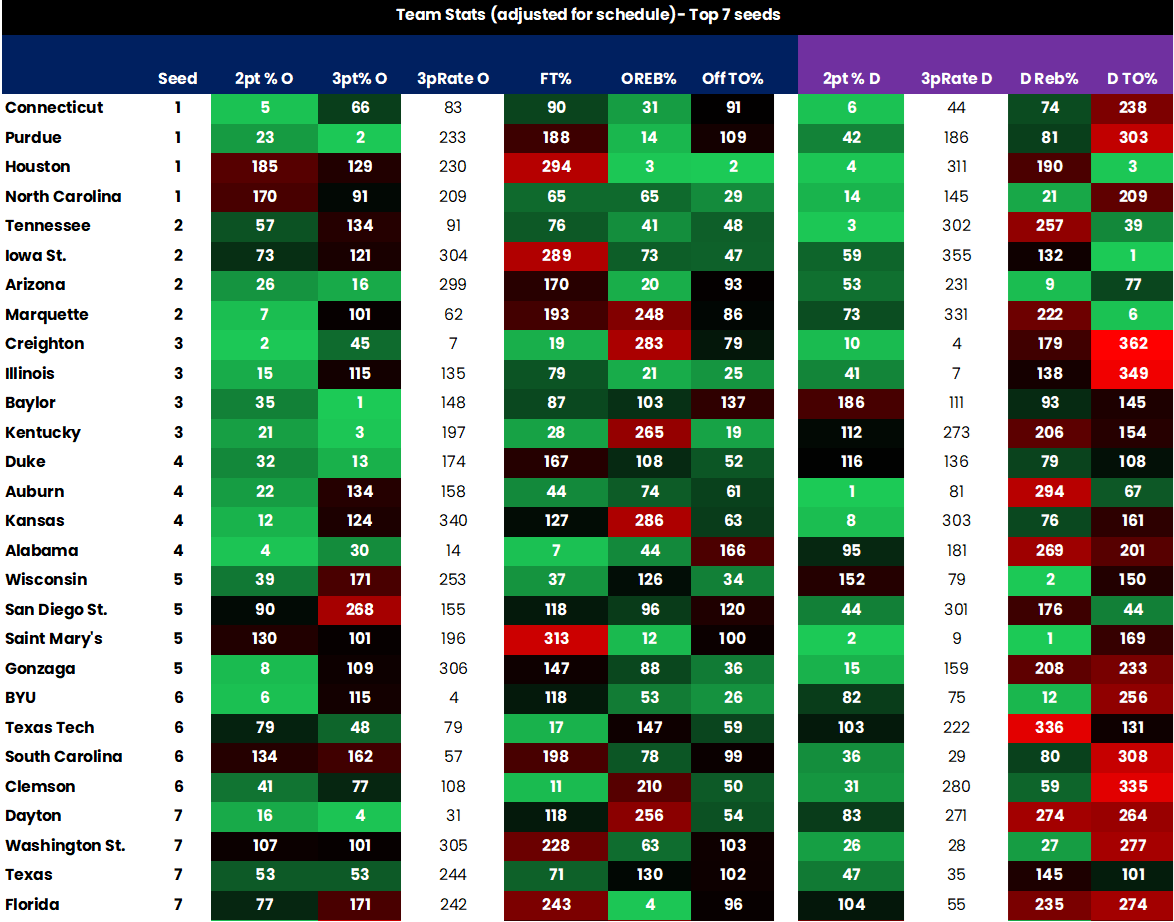
When evaluating those potential 11+ seed Cinderella teams, we would love to marry those that can slow down the pace, hit some 3s and face an opponent who doesn’t turn over teams at a high rate and will allow some offensive rebound opportunities. Top seeded teams like Creighton, Illinois, Kentucky, Alabama, Gonzaga, Dayton and Florida leap to the top of the list. It’s a very similar list to the vulnerable teams mentioned earlier.
Morehead St., Akron, McNeese St., Oakland are the slower paced teams and Charleston as a fast paced/very good offensive team that could find themselves in good early round matchups to keep an eye on.
Using Actual Odds vs Public
Comparing betting odds to win the title versus what the general public is picking can also help find good value. Using the table below to find teams that are undervalued from a championship standpoint in brackets is useful for large pools. (only teams with 1% or more win probability listed)


